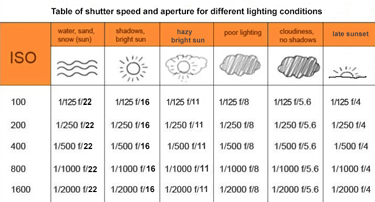Understanding the Sunny 16 lighting rules
There’s a good chance that if you are new to photography, or are happy with the results your camera produces using its auto setting, the Sunny 16 Rule won’t mean much to you. However, back in the old days, it was a good thing to remember because auto settings were not all that common.
Basically, the rule said that when you have sunny skies and distinct shadows, your lens opening was f/16 and the shutter speed was 1/.. of the film speed or today’s ISO number. Using modern times for an example, f/16 at an ISO speed of 200 would call for a shutter speed of 1/200th of a second, or as near to that as your camera will allow.
 Sunny and conditions such as snow or the beach called for a setting of f/22, slightly overcast or cloudy bright skies needed a setting of f/11, f/8 was used when it is overcast producing hardly any shadows, f/ 5.6 when it’s so overcast there are no shadows and f/4 for open shade or sunset when there’s no shadows.
Sunny and conditions such as snow or the beach called for a setting of f/22, slightly overcast or cloudy bright skies needed a setting of f/11, f/8 was used when it is overcast producing hardly any shadows, f/ 5.6 when it’s so overcast there are no shadows and f/4 for open shade or sunset when there’s no shadows.
So what does this all mean to you? Most of today’s cameras (unless you use spot metering) use a light averaging system to set your exposure. This means that the camera evaluates the bright areas and dark areas and gives you an exposure that is about ½ way in between the two. That may be ok when the two areas are about equal, but a greater or very bright area will produce a darker exposure making details in the shadows disappear. When the darker area is predominant, the exposure will brighter, burning out the details in the lighter area.
You have three options to get a more accurate exposure setting. 1) Use the Sunny 16 chart, 2) if the scene is predominately bright, tip your camera more toward the dark area, take a meter reading and lock it, or 3) if the scene is predominately dark, tip your camera more toward the light area, take a meter reading and lock it. Then, too, there’s your photo-editing program where you can adjust the lights and darks so the picture looks more like you remember it.
If this is too much to remember, copy the chart, resize it to your liking, print it, and put it in your camera bag for reference.
Best wishes for some great shots in the new year!
POSTED: 01/04/18 at 11:00 am. FILED UNDER: Camera Club News







